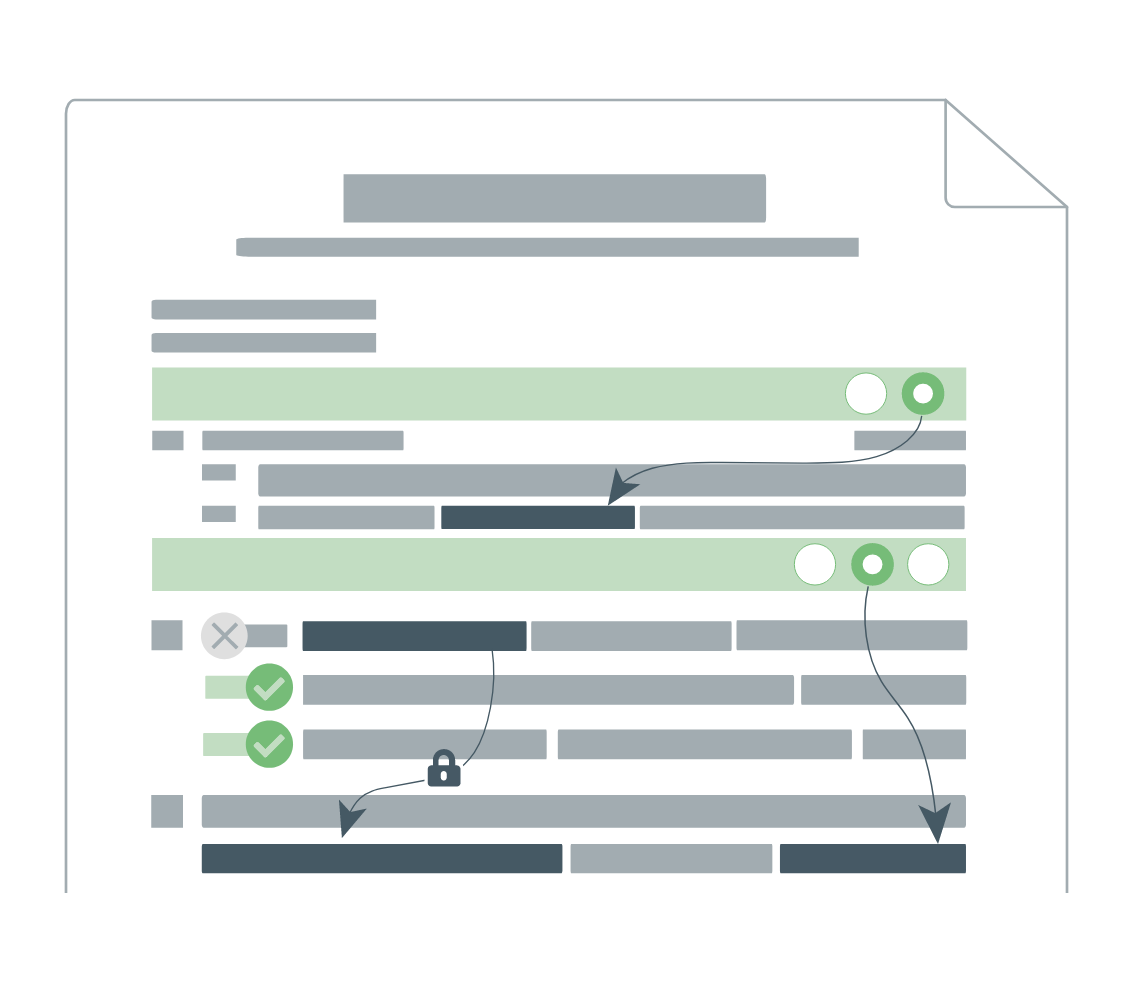Moving on from document automation
Moving on from document automation

Charles Drayson
Mar 17 · 5 min read

Charles Drayson
Mar 17 · 5 min read
I need to be clear about jargon in this article. Referring to ‘document automation’, I mean technology that creates documents based on data inputs. ‘Document assembly’ is another label for the same technology. A typical document automation tool uses a template encoded with logic (with programming scripts or no-code techniques like Legito). The template uses data to configure the output document, typically using a question-and-answer interview. Document automation differs from tools like mail merge or Word ‘Quick Parts’. Document automation permits a much clearer distinction between text content, logic layers to control the flow of the automation process, and more sophisticated ways to insert data into the document template.
Document automation tools have been around for a long time
Document automation tools have been around for a long time
Most products are good enough to achieve the results needed by most users if the desired results are limited to creating an output document with prescribed text and formatting. We will look later at what more you might want. Otherwise, vendors mostly differentiate their products based on ease of use, especially for authors.
No-code products, like Legito, are designed to allow authors to create templates without needing the help of a template developer.
The first solutions in the document automation market didn’t do much other than create documents. During that period, some solutions gained material market share. Thus we arrived at a situation where many users were invested in solutions that didn’t do anything else. That said, users enjoyed a good return on investment. It’s still the best place to start for most people likely to be reading this article.

Most products are good enough to achieve the results needed by most users if the desired results are limited to creating an output document with prescribed text and formatting. We will look later at what more you might want. Otherwise, vendors mostly differentiate their products based on ease of use, especially for authors. No-code products, like Legito, are designed to allow authors to create templates without needing the help of a template developer.
The first solutions in the document automation market didn’t do much other than create documents. During that period, some solutions gained material market share. Thus we arrived at a situation where many users were invested in solutions that didn’t do anything else. That said, users enjoyed a good return on investment. It’s still the best place to start for most people likely to be reading this article.

What comes next?
For many years, and perhaps for many current users of legacy solutions, the documents created from automation are absorbed into a business process and get amended, printed, emailed, signed, and stored on network drives, in traditional ways. Notice that there was very little re-use of the data used to generate the document. Attempting to extract that data from automated documents requires human review or the tricky business of using AI. The documents do not contain structured data – they are inherently unsuited to digital systems.
Sooner or later, document automation users want to use technology to augment the broader business processes.
Users start to notice clunky methods of getting data into a document automation solution. They notice wasted effort when that data is lost after the document assembly. Maybe they could use the data to re-run a template to make changes, but it could not readily be used for much else. If the data is available for use by any other system, somebody has to build a link to another system and map the data from one system to the other. The mapping differs for each template, and mapping needs to be done by someone with technical knowledge of both systems. Unsurprisingly, few people bothered.
What comes next?
For many years, and perhaps for many current users of legacy solutions, the documents created from automation are absorbed into a business process and get amended, printed, emailed, signed, and stored on network drives, in traditional ways. Notice that there was very little re-use of the data used to generate the document. Attempting to extract that data from automated documents requires human review or the tricky business of using AI. The documents do not contain structured data – they are inherently unsuited to digital systems.
Sooner or later, document automation users want to use technology to augment the broader business processes.
Users start to notice clunky methods of getting data into a document automation solution. They notice wasted effort when that data is lost after the document assembly. Maybe they could use the data to re-run a template to make changes, but it could not readily be used for much else. If the data is available for use by any other system, somebody has to build a link to another system and map the data from one system to the other. The mapping differs for each template, and mapping needs to be done by someone with technical knowledge of both systems. Unsurprisingly, few people bothered.
Review, approvals, signatures…
Next, users notice the lack of workflow, even if they don’t recognise workflow as a concept. Workflow describes a business process runs from beginning to end. It’s a series of steps that typically includes review, approvals and signatures. In the absence of workflow tools, the process is usually done manually with email. Success depends on the organisational skills of the users. If the process is cumbersome, users will find ways to cut corners. It’s easier to get forgiveness than permission.
If document automation is used to generate a volume of documents, it becomes apparent that document automation doesn’t include tools for creating reports, management information or gaining insight about how things are working. It’s also hard to run searches against the documents.

Review, approvals, signatures…
Next, users notice the lack of workflow, even if they don’t recognise workflow as a concept. Workflow describes a business process runs from beginning to end. It’s a series of steps that typically includes review, approvals and signatures. In the absence of workflow tools, the process is usually done manually with email. Success depends on the organisational skills of the users. If the process is cumbersome, users will find ways to cut corners. It’s easier to get forgiveness than permission.
If document automation is used to generate a volume of documents, it becomes apparent that document automation doesn’t include tools for creating reports, management information or gaining insight about how things are working. It’s also hard to run searches against the documents.

Gaps in document automation
Vendors of legacy solutions found it hard to retrofit tools to plug the gaps in document automation. Their code was old and harder to re-work, and they wanted to avoid the cost and risk associated with starting with a fresh codebase. They faced the technical challenge of building new features that are backward compatible for their existing customers, who had built large template libraries. Vendors were slower than customers to recognise the gaps. It wasn’t easy for vendors to earn extra revenue to pay for new features because price increases might prompt existing customers to look at other market options. The scene was set for new market entrants to create applications with a suite of features, using the latest technology, and unfettered by the need to maintain legacy code and legacy customers. Legito was born against that background.
Legacy vendors had a big market share, but it was a large share of a relatively small proportion of organisations who had adopted document automation. Many organisations were not invested in legacy solutions at all – creating space for exciting new solutions. Moreover, the legacy solutions were adopted almost entirely by lawyers from law firms and corporate legal teams. That’s not surprising: lawyers could get value from document automation regardless of the limited scope of document automation solutions. Pure document automation solutions were less attractive to the wider business community.
Gaps in document automation
Vendors of legacy solutions found it hard to retrofit tools to plug the gaps in document automation. Their code was old and harder to re-work, and they wanted to avoid the cost and risk associated with starting with a fresh codebase. They faced the technical challenge of building new features that are backward compatible for their existing customers, who had built large template libraries. Vendors were slower than customers to recognise the gaps. It wasn’t easy for vendors to earn extra revenue to pay for new features because price increases might prompt existing customers to look at other market options. The scene was set for new market entrants to create applications with a suite of features, using the latest technology, and unfettered by the need to maintain legacy code and legacy customers. Legito was born against that background.
Legacy vendors had a big market share, but it was a large share of a relatively small proportion of organisations who had adopted document automation. Many organisations were not invested in legacy solutions at all – creating space for exciting new solutions. Moreover, the legacy solutions were adopted almost entirely by lawyers from law firms and corporate legal teams. That’s not surprising: lawyers could get value from document automation regardless of the limited scope of document automation solutions. Pure document automation solutions were less attractive to the wider business community.
Legito is built around the core document automation requirements, albeit with a modern user interface and a no-code approach to building templates. Most organisations still start with document automation. However, Legito is designed as an enterprise-wide application that supports the full lifecycle of a document. The data used to generate a document is also available to power all the other features.
Legito is built around the core document automation requirements, albeit with a modern user interface and a no-code approach to building templates. Most organisations still start with document automation. However, Legito is designed as an enterprise-wide application that supports the full lifecycle of a document. The data used to generate a document is also available to power all the other features.
Start with incremental steps
The best way to move beyond document automation is to take incremental steps. Let the solution evolve rather than aim for a big-bang approach. It is possible to build a complete end-to-end process in Legito from the start. However, you run the risk of overlooking the nuances of your business processes and discovering too late that real-life workflow isn’t as simple as the flow chart you created. You don’t need to create a big IT project with all the associated risks.
Here are some features you can adopt when you are ready to extend beyond document automation:
- Document management, including assimilating documents that didn’t originate in Legito. Document management is a way to store and retrieve documents without the limitations of filing them on a network drive.
- Workflow. Use workflow to track the stages in the lifecycle of a document. It’s a tracking and organisation tool. But it’s also a compliance tool. Tip: the objective is to model the key stages – you don’t need to burden users with a workflow that leaves no room for flexibility.
- Dashboards and reports. Use the data from document automation to power dashboards, reports and analytics. Customise dashboards to show the data you need for daily guidance. Keep an eye on dates for upcoming contract renewals, for example.
- Digital signatures. Services like DocuSign are quicker than traditional methods for gathering signatures. Integrated with Legito, people can more easily review documents before they sign. Signed documents are stored in the same digital medium with document management.
- Objects. Legito ‘objects’ allow you to describe your documents and data to meet the specific requirements of a business team. For example, the HR team might use objects to organise and view employee records. Employee records will have information specific to employees. The Procurement team might use objects to organise supplier commitments, and those records will be specific to suppliers.
Start with incremental steps
The best way to move beyond document automation is to take incremental steps. Let the solution evolve rather than aim for a big-bang approach. It is possible to build a complete end-to-end process in Legito from the start. However, you run the risk of overlooking the nuances of your business processes and discovering too late that real-life workflow isn’t as simple as the flow chart you created. You don’t need to create a big IT project with all the associated risks.
Here are some features you can adopt when you are ready to extend beyond document automation:
- Document management, including assimilating documents that didn’t originate in Legito. Document management is a way to store and retrieve documents without the limitations of filing them on a network drive.
- Workflow. Use workflow to track the stages in the lifecycle of a document. It’s a tracking and organisation tool. But it’s also a compliance tool. Tip: the objective is to model the key stages – you don’t need to burden users with a workflow that leaves no room for flexibility.
- Dashboards and reports. Use the data from document automation to power dashboards, reports and analytics. Customise dashboards to show the data you need for daily guidance. Keep an eye on dates for upcoming contract renewals, for example.
- Digital signatures. Services like DocuSign are quicker than traditional methods for gathering signatures. Integrated with Legito, people can more easily review documents before they sign. Signed documents are stored in the same digital medium with document management.
- Objects. Legito ‘objects’ allow you to describe your documents and data to meet the specific requirements of a business team. For example, the HR team might use objects to organise and view employee records. Employee records will have information specific to employees. The Procurement team might use objects to organise supplier commitments, and those records will be specific to suppliers.
The 80/20 rule
You can buy applications that do everything listed above and try to integrate them. To some extent, a pure workflow tool, for example, might provide more access to more complex workflow features. Buying a document management system will provide access to more complex document management features.
Buying an assortment of specialist solutions creates at least three chunky problems:
- users need to know how to use multiple systems,
- somebody has to build and manage the integrations and
- it’s expensive.
The Pareto principle (the 80/20 rule) is relevant here. You get most of the benefits from the core features of each component. You could find yourself battling unfathomable complexity if you try to be clever by using esoteric features to handle intricacies that are best left to humans (or best not done at all).
The 80/20 rule
You can buy applications that do everything listed above and try to integrate them. To some extent, a pure workflow tool, for example, might provide more access to more complex workflow features. Buying a document management system will provide access to more complex document management features.
Buying an assortment of specialist solutions creates at least three chunky problems:
- users need to know how to use multiple systems,
- somebody has to build and manage the integrations and
- it’s expensive.
The Pareto principle (the 80/20 rule) is relevant here. You get most of the benefits from the core features of each component. You could find yourself battling unfathomable complexity if you try to be clever by using esoteric features to handle intricacies that are best left to humans (or best not done at all).
Legito exists to support humans, not overwhelm them, or force them to work with a system that bites back. Before you bend technology to make it replicate a messy business process, consider whether the business process could be simpler.
Legito exists to support humans, not overwhelm them, or force them to work with a system that bites back. Before you bend technology to make it replicate a messy business process, consider whether the business process could be simpler.
We don’t believe that all organisations need all the features provided by Legito. Instead, we believe that most organisations will expand and evolve their automation solutions over time. Our CEO said it’s like going to a restaurant with a big menu: we don’t expect you to eat everything on the menu, but we know you will want to try more dishes over time.
We don’t believe that all organisations need all the features provided by Legito. Instead, we believe that most organisations will expand and evolve their automation solutions over time. Our CEO said it’s like going to a restaurant with a big menu: we don’t expect you to eat everything on the menu, but we know you will want to try more dishes over time.
More Industry Insights


















